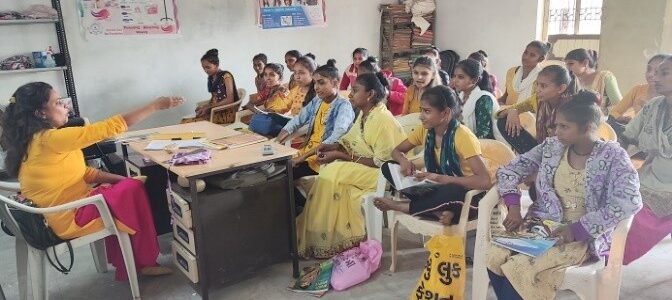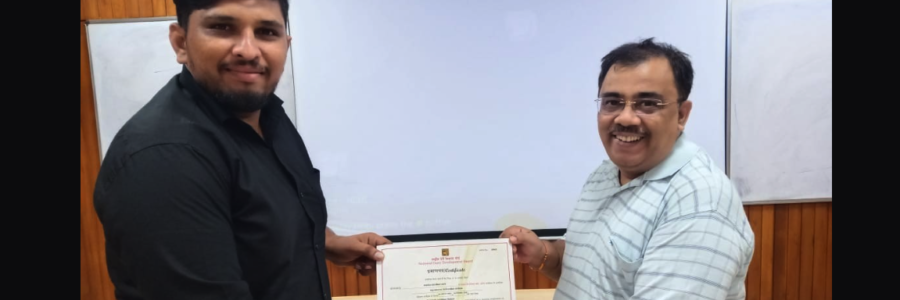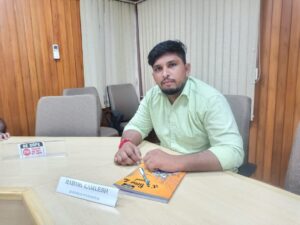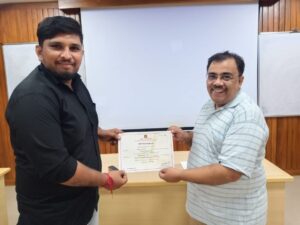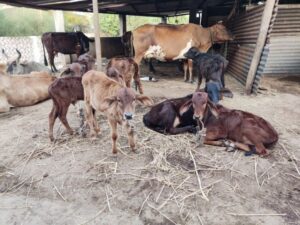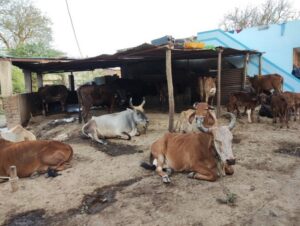Approximately 48% of the total population in Umraya (a village in Vadodara district of Gujarat) are females with the 66.97% literacy rate. The village has two Government schools (primary and middle) till 8th standard. Those who wish to pursue studies after 8th go to either Ekalbara or Dabhasa (~3 to 10 km away). Not all and mostly girls are unable to continue their education after 8th due to various reasons such are availability of reliable transport, safety, affordability etc. Additionally, most of the parents are not interested or concerned about girl child’s education and prefer to marry them of as soon as they attain the legal age.
During the consultations in various phases of interaction and during faliya meetings, young women shared that while their families do not promote further education but don’t mind them having an opportunity to earn within the village or nearby areas. Many young women who are educated and are willing to work are not aware about avenues available which could provide employment opportunities within the village. It was observed that there is a significant gap between the aspiration, skills and competences for the employability among women.
Through the Huntsman CSR interventions we had envisaged to bridge the skilling gap, increase opportunities and enhance employability for village youth. Several options were discussed with the target group during the meetings and courses on nursing, beautician, computer education, spoken English, personality development were discussed. Information was shared during focus groups in each of the faliya is the village. Owing to a higher demand by girls to learn beauty services, a training program was initiated.
An intensive screening process was conducted, based on criteria such as minimum age be 18 years and above, dropped out from the school/college, current resident, seriousness and readiness to face exam, inclination to work etc.

Picture 1: Information sharing, counselling and form filling for the Assistant Beauty Therapist Training Course
Dev Foundation, Vadodara was chosen as a training partner for imparting NSDC approved training of assistant beauty therapist. The process of onboarding candidates to the course was done in a systematic way by organising meetings with potential candidates for further screening, understand their expectation and willingness to devote the requisite time. During the discussion some of the candidates shared their expectation to learn applying Mehendi and bridal makeup. Consequently, these new topics were also included in the course curriculum.
26 girls undertook the course. Majority of the trainees were unmarried girls- youngest trainee being 18 years old & eldest was 28 years old, lowest education being 8th standard whereas graduation being the highest. Total course duration was 290 hours that included 50 hours of theory, 250 hours of practical sessions and 40 hours for employability & entrepreneurship segment.
Dev Foundation deployed a well-trained, experienced trainer to impart the training. The tenure of the training course was very important for the trainees to acquire skills as well to understand their capacity and preparedness to take up occupation for income generation. The training period was very eventful and interesting for all the trainees and organizations associated with.


Pictures 2 & 3: Eyebrow training & practice; Yellow Day celebration at the center
We conducted regular feedback sessions individually or in groups to understand quality of training, availability of required equipment or material for practice and about issues they are facing, if any. Regular interaction was done with the trainer to understand the capabilities, behaviour, receptivity and inter-personal skills of the trainees & other house-keeping issues.
Girls are always sensitive towards the beauty but perception and knowledge differs from person to person. The training includes scientific and practical information on skin and body care. Many of the girls came to know about the skin and body care for the first time.


Pictures 4 & 5: Facial and bridal make up training during the course
All the girls started working during the training period itself, within the family, neighborhood and several even serving to the customer from the village and nearby. The maximum earning by a trainee is INR 13,790 and all the girls had served 2 to 30 customers each during the training itself.
Shabanabanu Hashusha Diwan, one of the trainees had received similar training before but was not practicing, as she did not feel confident enough to start working professionally. We facilitated her to apply for the Garib Kayan Scheme and she was then sanctioned the kit for beauty parlour under the same. She earned INR 6,500 just from two orders. She expressed that she wishes to start her own parlour in the village and is open to join hands with her trained friends from the class. Likewise, others are also highly enthusiastic for the future. 9 of them are ready to open their own parlour and others want to work in bigger parlours in Padra and Vadodara.
For the girls, the course was also a means towards their financial & social inependence. It helped to increase their mobility outside of their homes, meet other girls and learn in a group which helped them not only to develop personally but also as professionals.

Picture 6: Group Photograph on the day of exam

